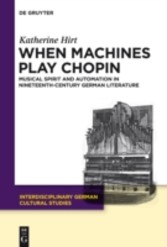Suchen und Finden
Mehr zum Inhalt

When Machines Play Chopin - Musical Spirit and Automation in Nineteenth-Century German Literature
Chapter Four Virtuosity and the Experience of Listening in Heinrich Heine’s Music Criticism and “Florentine Nights” (p. 92-93)
Heinrich Heine’s music aesthetics have been given very little attention in Heine scholarship in spite of his influence on the reputations of various musicians and on musical performance practices. The reason for the small amount of scholarship on Heine’s music criticism is twofold: on the one hand, Heine’s contemporaries claimed that he did not know much about, or even like music (Mann, Wehrmann), and on the other, music and music criticism has evolved between the mid-nineteenth and twentieth centuries to eliminate reviews by listeners such as Heine who have no or very little background in music. In order to convince current scholars, a study today on music reviews by someone with minimal background in music, such as Heine, would have to question the validity of the aesthetic statements in the reviews. The way scholars treat Heine’s music criticism contrasts greatly to their attitudes about Hoffmann’s writings. Writing about Hoffmann’s music aesthetics does not pose a problem for twentieth-century and present-day critics because Hoffmann was a known composer and had substantial music training before beginning his writing career. Unlike scholarship on Hoffmann, most studies on Heine and music deal with song-settings to his poems and do not focus on what Heine himself has to say about music in his reviews and stories. The few twentieth-century studies that do exist on Heine’s music aesthetics (Bernstein, Betz, Müller, Wehrmann) focus on other themes in the writing that have very little to do with the music heard on stage.
Twentieth and twenty-first century decisions about whose criticism is most important points more to the shift in attitudes about credibility in music criticism between the nineteenth and twentieth centuries than the validity of the critics’ aesthetic judgments. Dahlhaus and Wehrmann both emphasize that influential and respected critics in the eighteenth and early nineteenth centuries often had very little musical training (Dahlhaus 23; Wehrmann 79). As Albrecht Betz indicates in his essay on Heine’s reviews and the Parisian music culture, the music critics represented the majority of the audience whose understanding of music was based on thesounds they heard rather than the technical knowledge of how the composition fits together (159). Musical training actually could invalidate a music critic’s assessment about a performance. To avoid this, as Dahlhaus explains, well-known composers such as Robert Schumann and Hoffmann would write under a pseudonym or express in their reviews how little they know about music, so that their concentration would be on an aesthetic rather than technical judgment about the composition or performance (23). That Heine’s music criticism has been met with such skepticism due to his contemporaries’ claims about his distaste for music shows the change in attitudes in the mid-nineteenth century about who can critique performances. It is unfortunate that Heine’s music aesthetics in his reviews and in combination with the Paganini review in “Florentine Nights” has been so overlooked because the reviews and the novella have much to say about musical developments in the nineteenth century, particularly in performance practices and the relationship between mechanical aspects of creativity and artistic genius.
Heine’s exile in Paris and events in Paris at the time contributed much to the content of his reviews and the social environment in which he wrote. In general, the relationship between music and the machine in literature of the nineteenth century tends to cross borders, limiting a discussion of place.
Alle Preise verstehen sich inklusive der gesetzlichen MwSt.






